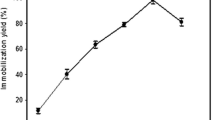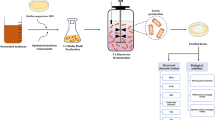Abstract
Isomaltulose is a potential substitute for sucrose, with a high stability and prebiotic potential, for wide use in candies and soft drinks. This sugar is obtained from sucrose through enzymatic conversion using microbial glucosyltransferases. This work aimed to optimize a matrix to immobilize glucosyltransferase producing Erwinia sp. D12 cells using a sequential experimental strategy. The cell mass of Erwinia sp. D12 obtained in a bioreactor was immobilized in beads formed by ionic gelation. The conversion of sucrose into isomaltulose using the beads was performed in batch and continuous processes, and the isomaltulose was recovered through crystallization. The stability of isomaltulose was assessed in beverages of different pH values, and its prebiotic potential was verified with the growth of probiotic microorganisms. The optimized matrix composed of alginate (2.0% w/v), CaCl2 (2.0% w/v), gelatin (2.0% w/v), and transglutaminase (0.2% w/v) showed the highest mean of produced isomaltulose (199.82 g/L) after four batches. In addition, high stability during the continuous process resulted in an isomaltulose production above of 230 g/L for up to 72 h. The produced isomaltulose was more stable than sucrose in lemon soft drink and orange and grape energy drinks after 30 days of storage; and promoted the growth of Bifidobacterium animalis and Lactobacillus lactis. In conclusion, the production of isomaltulose by Erwinia sp. D12 cells immobilized using optimized conditions is recommended, due to its high conversion capacity, high stability, and prebiotic potential of crystals obtained.




Similar content being viewed by others
Availability of data and materials
This manuscript has no associated data.
References
Bracho-Oliveros JP, Ramirez-Gutierrez AC, Ezequiel-Ortiz G, Contreras-Esquivel JC, Cavalitto SF (2020) In: Contreras-Esquivel JC, Badwaik LS, Kannan P, Haghi AK (eds) Food product optimization for quality and safety control: Process, monitoring, and standards, 1st edn. Taylor & Francis, New York
Shyam S, Ramadas A, Chang SK (2018) Isomaltulose: Recent evidence for health benefits. J Funct Foods 48:173–178
Carvalho PH, Kawaguti HY, de Souza WFC, Sato HH (2021) Immobilization of Serratia plymuthica by ionic gelation and cross-linking with transglutaminase for the conversion of sucrose into isomaltulose. Bioprocess Biosyst Eng 44:1109–1118
Sawale PD, Shendurse AM, Mohan MS, Patil GR (2017) Isomaltulose (Palatinose)—an emerging carbohydrate. Food Biosci 18:46–52
de Oliva-Neto P, Menão PTP (2009) Isomaltulose production from sucrose by Protaminobacter rubrum immobilized in calcium alginate. Bioresour Technol 100(18):4252–4256
Orsi DC, Sato HH (2016) Isomaltulose production using free and immobilized Serratia plymuthica cells. Afr J Biotechnol 15(20):835–842
Orsi DC, Kawaguti HY, Sato HH (2009) Glucosyltransferase production by Klebsiella sp. K18 and conversion of sucrose to palatinose using immobilized cells. Braz J Microbiol 40(1):66–72
Li L, Wang H, Cheng H, Deng Z (2017) Isomaltulose production by yeast surface display of sucrose isomerase from Pantoea dispersa on Yarrowia lipolytica. J Funct Foods 32:208–217
Chibata I, Tosa T (1983). In: Chibata I (ed) Applied biochemistry and bioengineering, 4th edn. Academic Press, Cambridge
Pinguli L, Troja R, Malollari I, Gurazi V, Vaso T (2020) A comparative study of free and immobilized brewing yeast fermentation performance based on kinetic parameters. Bulg J Agric Sci 26(4):899–905
Simó G, Fernández-Fernández E, Vila-Crespo J, Ruipérez V, Rodríguez-Nogales JM (2017) Research progress in coating techniques of alginate gel polymer for cell encapsulation. Carbohydr Polym 170:1–14
Kurozawa LE, Hubinger MD (2017) Hydrophilic food compounds encapsulation by ionic gelation. Curr Opin Food Sci 15:50–55
Yushkova ED, Nazarova EA, Matyuhina AV, Noskova AO, Shavronskaya DO, Vinogradov VV, Krivoshapkina EF (2019) Application of immobilized enzymes in food industry. J Agr Food Chem 67:11553–11567
Cantone S, Ferrario V, Corici L, Ebert C, Fattor D, Spizzo P, Gardossi L (2013) Efficient immobilization of industrial biocatalysts: Criteria and constraints for the selection of organic polymeric carriers and immobilization methods. Chem Soc Rev 42:6262–6276
Martins E, Poncelet D, Rodrigues RC, Renard D (2017) Oil encapsulation techniques using alginate as encapsulating agent: applications and drawbacks. J Microencapsul 34:754–771
Rodrigues FJ, Cedran MF, Bicas JL, Sato HH (2020) Encapsulated probiotic cells: Relevant techniques, natural sources as encapsulating materials and food applications—a narrative review. Food Res Int 137:109682
Cerqueira MA, Bourbon AI, Pinheiro AC, Martins JT, Souza BWS, Teixeira JA, Vicente AA (2011) Galactomannans use in the development of edible films/coatings for food applications. Trends Food Sci Technol 22(12):662–671
Xing Q, Yates K, Vogt C, Qian Z, Frost MC, Zhao F (2014) Increasing mechanical strength of gelatin hydrogels by divalent metal ion removal. Sci Rep 4:1–10
Vilaró P, Bennadji Z, Budelli E, Moyna G, Panizzolo L, Ferreira F (2018) Isolation and characterization of galactomannans from Prosopis affinis as potential gum substitutes. Food Hydrocoll 77:711–719
Gong P, Di W, Yi H, Sun J, Zhang L, Han X (2019) Improved viability of spray-dried Lactobacillus bulgaricus sp1.1 embedded in acidic-basic proteins treated with transglutaminase. Food Chem 281:204–212
de Souza WFC, de Lucena FA, da Silva KG, Martins LP, de Castro RJS, Sato HH (2021) Influence of edible coatings composed of alginate, galactomannans, cashew gum, and gelatin on the shelf- life of grape cultivar ‘Italia’: physicochemical and bioactive properties. LWT Food Sci Technol 152:112315
Kawaguti HH, Buzzato MF, Orsi DC, Suzuki GT, Sato HH (2006) Effect of the additives polyethylenimine and glutaraldehyde on the immobilization of Erwinia sp. D12 cells in calcium alginate for isomaltulose production. Process Biochem 41(9):2035–2040
Rodrigues MI, Iemma AF (2014) Experimental design and process optimization. Cárita, Campinas, São Paulo, Brazil
Kawaguti H, Sato HH (2010) Effect of concentration and substrate flow rate on isomaltulose production from sucrose by Erwinia sp. cells immobilized in calcium-alginate using packed bed reactor. Appl Biochem Biotechnol 162(1):89–102
Kawaguti HH, Sato HH (2011) Production of isomaltulose obtained by Erwinia sp. cells submitted to different treatments and immobilized in calcium alginate. Ciênc Tecnol Aliment 31(1):257–263
Nawawi NN, Hashim Z, Rahman RA et al (2020) Entrapment of porous cross-linked enzyme aggregates of maltogenic amylase from Bacillus lehensis G1 into calcium alginate for maltooligosaccharides synthesis. Int J Biol Macromol 150:80–89
Kawaguti HY, Carvalho PH, Figueira JA, Sato HH (2011) Immobilization of Erwinia sp. D12 cells in alginate-gelatin matrix and conversion of sucrose into isomaltulose using response surface methodology. Enzyme Res 2011:1–8
Gibson GR, Hutkins R, Sanders ME, Prescott SL, Reimer RA, Salminen SJ, Reid G (2017) Expert consensus document: The International Scientific Association for Probiotics and Prebiotics (ISAPP) consensus statement on the definition and scope of prebiotics. Nat Rev Gastroenterol Hepatol 14(8):491–502
Arruda HS, Pereira GA, Almeida MEF, Neri-Numa IA, Sancho RAS, Molina G, Pastore GM (2017) In: Atta-ur-Rahman FRS (ed) Frontiers in natural product chemistry, 3rd edn. Bentham Books, Sharjah, UAE
Scott KP, Grimaldi R, Cunningham M, Sarbini SR, Wijeyesekera A, Tang MLK, Gibson GR (2020) Developments in understanding and applying prebiotics in research and practice—an ISAPP conference paper. J Appl Microbiol 128(4):934–949
Su HH, Xu RY, Yang ZD, Guo YS, Gao JY, Mo LZ, Huang JS (2021) Green synthesis of isomaltulose from cane molasses by an immobilized recombinant Escherichia coli strain and its prebiotic activity. LWT Food Sci Technol 143:1–9
Pranckute R, Kaunietis A, Kuisiene N, Čitavičius D (2014) Development of synbiotics with inulin, palatinose, α-cyclodextrin and probiotic bacteria. Pol J Microbiol 63(1):33–41
Acknowledgements
The authors would like to thank CAPES for funding, the Department of Food Science and Nutrition from the School of Food Engineering, University of Campinas, and EMPRAPA algodão (Campina Grande, Paraíba, Brazil).
Funding
This work was supported in part by the Coordenação de Aperfeiçoamento de Pessoal de Nível Superior, Brazil (CAPES), Finance Code 001 (PROEX process number 88887.336842/2019-00).
Author information
Authors and Affiliations
Contributions
All authors contributed to the development of this research, which are as follows: WFCdS: conceptualization, methodology, investigation, data curation, writing—original draft, writing—review and editing. RJSdC: conceptualization, methodology, writing—review and editing, supervision. HHS: conceptualization, methodology, resources, writing—review and editing, supervision, project administration, funding acquisition.
Corresponding author
Ethics declarations
Conflict of interest
The authors declare that they have no conflict of interest.
Additional information
Publisher's Note
Springer Nature remains neutral with regard to jurisdictional claims in published maps and institutional affiliations.
Rights and permissions
About this article
Cite this article
de Souza, W.F.C., de Castro, R.J.S. & Sato, H.H. Sequential optimization strategy for the immobilization of Erwinia sp. D12 cells and the production of isomaltulose with high stability and prebiotic potential. Bioprocess Biosyst Eng 45, 999–1009 (2022). https://doi.org/10.1007/s00449-022-02719-7
Received:
Accepted:
Published:
Issue Date:
DOI: https://doi.org/10.1007/s00449-022-02719-7




